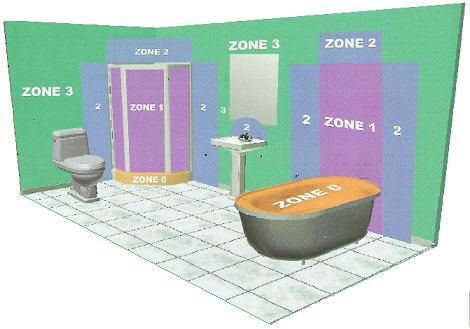Bathrooms:
Great care needs to be taken when choosing bathroom lighting as the regulations are strict concerning the type of light you can use.
The bathroom mirror deserves some special attention and a diffused glass light either side will give a good general illumination where it is needed.
The alternative is a halogen strip light over the mirror.
The latest generation of mirrors incorporate lights into the mirrors themselves with section of the reflective surface removed and lights fitted behind them. This is a very effective way of generating an even light and improving safety.
For general illumination in the rest of the bathroom either use downlights for their refreshing halogen colour or a high output flush ceiling fitting to suit the décor.
Portable lights are not permitted in a bathroom so for mood lighting use ceiling mounted directional spotlights aimed away from the bath and at interesting features. Lights designed specifically for showers are available and must be carefully fitted according to the manufacturers instructions.
The following information is a guide to help you understand what fittings can be place where. This is not an installation guide and reference should be made to the IEE Wiring Regulations (16th Edition) or a qualified electrician.
Firstly it is important to understand the rating by which bathroom and some outdoor light are classified. IP rating stands for ‘Ingress Protection’ and is always followed by two characters.
These two numbers refer to the level of protection and it is important that you choose fittings with the correct rating according to where they are to be sited within the bathroom.
The diagrams below show a bathroom split into four clear zones: 0, 1, 2 and 3.

- Zone 0 – is inside the bath or shower itself. Any fitting used in this zone must be low voltage, (max 12v) and be rated at least IP67 which is total immersion proof.
- Zone 1 – is the area above the bath to a height of 2.25m from the floor. In this zone a minimum rating of IP44 is required. If the fitting is 240v a 20ma residual current device (RCD) must also be used to protect the circuit in this zone.
- Zone 2 – is the area stretching 0.6m outside the perimeter of the bath and to a height of 2.25m from the floor. In this zone an IP rating of at least IP44 is required. In addition it is good practice to consider the area around a wash basin, within a 60cm radio of any tap to be considered as zone 2.
- Zone 3 – is anywhere outside zones 0, 1 and 2 (subject to specific limits) and where no water jet is likely to be used. No IP rating is required.
In addition to the above, if there is a likelihood of water jets being used for cleaning purpose in zones 1,2 and 3 a fitting rated a minimum IP65 must be used.
Full details can be found in the latest copy of the IEE wiring regulations.
You may also wish to read IP Ratings Explained.
Bedroom:
This is an area so often neglected. Consider the number of functions required of a bedroom.
For dressing you may need a general illumination or, if your partner has to rise at a different time, do you need a lower level pool of light which won’t disturb them? A well positioned down lighter will help here.
Many people read in bed and with a double room, it is useful to have bedside lights which are individually switched. Adjustable reading lamps are ideal if you want to read while your partner sleeps. For convenience and safety you should aim to have all of the bedroom lights controlled from the bed.
Dressing tables used for make-up will need more specific lighting and the use of two slender table lamps either side of a mirror gives a good working light without glare and will add to the cozy effect of the room.
Try to create pools of light to reduce any harsh contrasts. Adding a table lamp or illuminating pictures will be very effective.
Study/Den:
A general background illumination is important to avoid the hard contrast if only a desk lamp is used. Indirect wall washers or a floor lamp will do nicely.
For the desk lamp look for one which is adjustable for height and will reach over the area where you are working. It is most important to avoid working in shadows.
If you have a computer try and light the wall behind it to avoid tiring your eyes when looking at the screen. Make sure the lights in the room do not reflect off the screen into your eyes.
Children’s Rooms:
A good central ceiling light is useful to provide a general illumination and a bedside or wall mounted reading lamp is recommended.
Night light for children’s rooms give peace of mind and cost very little to run.
Older children will want to have fun lighting and there are many effective novelty lights but always be safety conscious and choose lights which are suitable for the age of the child.
Please Note: - The information here is intended as a guide and contains several generalizations for illustrative purposes. For more technical information refer to an electrician and specific product data.
